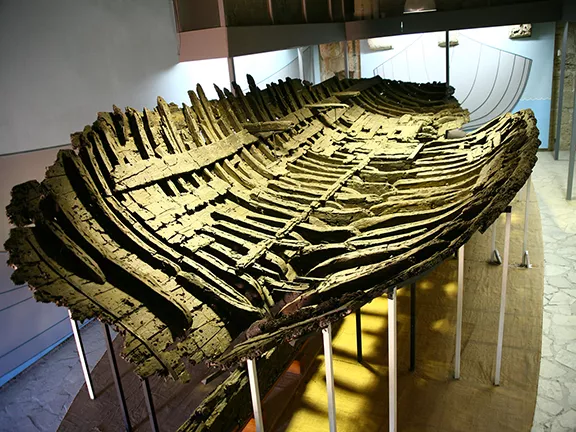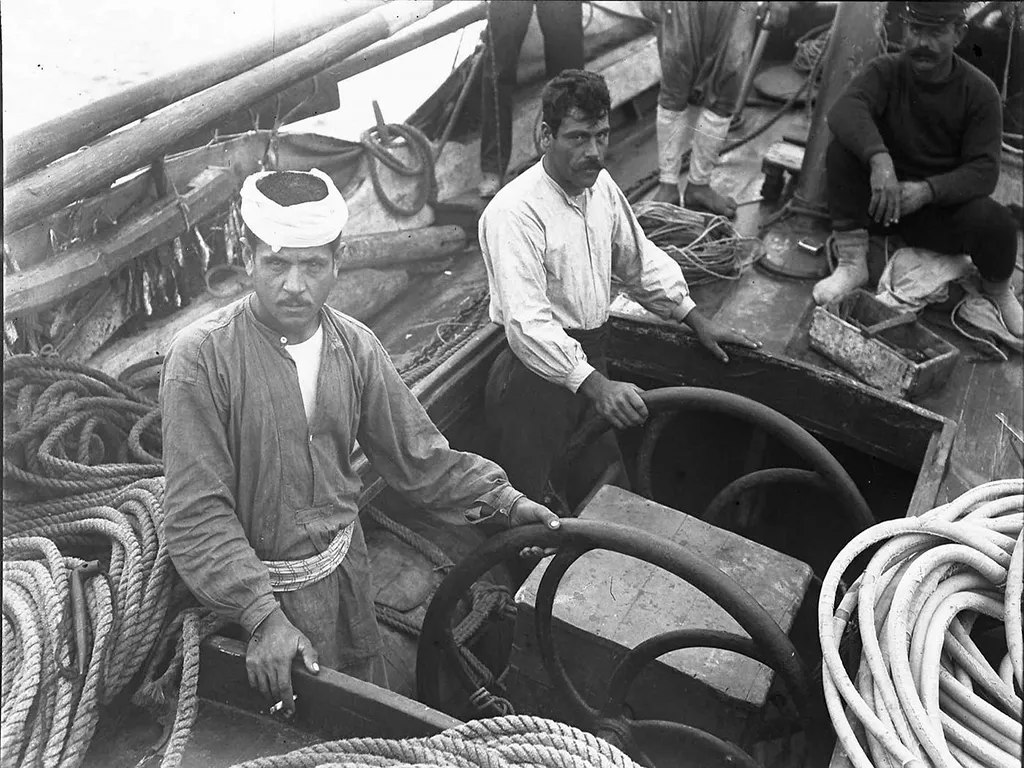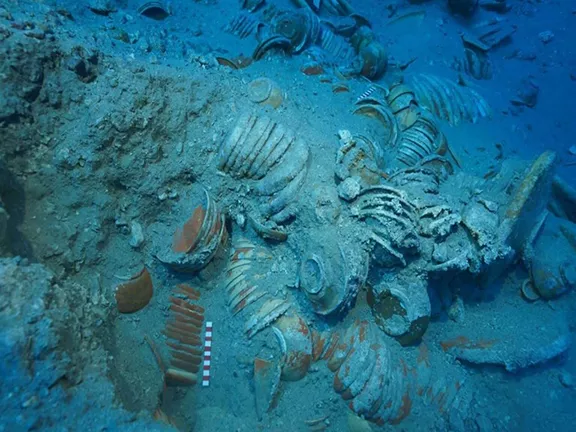Roman Era Shipwrecks in the Mediterranean
Antikythera Shipwreck: Unearthing Ancient Secrets & The First Computer
Explore the Antikythera shipwreck, its 1900 discovery, Roman-era dating (60-50 BC), and the revolutionary Antikythera Mechanism. Learn about ongoing excavations (2025 finds), diverse cargo, and the ship's mysterious sinking.
By Nick Nutter on 2025-07-10 | Last Updated 2025-07-11 | Roman Era Shipwrecks in the Mediterranean
This article has been visited 2,652 times

Antikythera Wreck Site
The Antikythera Shipwreck
The Antikythera shipwreck is a Roman-era shipwreck that continues to fascinate archaeologists and historians. Discovered in 1900, it has yielded an incredible array of artifacts, most famously the intricate Antikythera Mechanism. Ongoing research, utilizing cutting edge technology, continues to uncover new secrets about this ancient vessel and its rich cargo.
Do you enjoy my articles? For your reading pleasure, this website does not carry third party ads. You could help me write more articles by buying me a cup of coffee.
Discovery and Initial Excavation
The Antikythera shipwreck was discovered by sponge divers Lazaros Pitharidis and Giannis Andreadis on May 17, 1900, off Point Glyphadia on the Greek island of Antikythera. While diving off the coast of this small island in the Aegean Sea, they encountered a large, marine-encrusted object on the seabed, which they believed to be a shipwreck.
The divers reported their find to local authorities, prompting the Greek government to swiftly organize an expedition. Over the following year (1900-1902), divers conducted the initial excavation, recovering a significant number of artifacts. These included bronze and marble statues, pottery, jewellery, coins, and the severely corroded remnants of the Antikythera Mechanism.
Valerios Stais, a Greek archaeologist, led this initial excavation. All recovered artifacts are now on display at the National Archaeological Museum of Athens.
Dating the Shipwreck


Left Arm of Boxer - Antikythera Wreck - National Archaeological Museum Athens
The Antikythera shipwreck is definitively dated to the first half of the 1st century BC, specifically between 60 and 50 BC. This dating is based on various lines of evidence from the recovered artifacts:
Coins
The precise dating of the Antikythera shipwreck largely hinges on the numismatic evidence recovered from the site, specifically the approximately 300 coins found. The most chronologically significant among these are the silver cistophoric tetradrachms, a common currency in the eastern Mediterranean during the Hellenistic period. The latest minting dates identified for these particular coins fall between 76 and 67 BC. This suggests that the ship could not have sunk before 67 BC, as coins minted after that date are absent from this primary hoard. The overall composition of this large coin group, combined with the absence of later cistophoric issues that would have been in widespread circulation, provides a strong terminus post quem (the "date after which") for the shipwreck.
While the bulk of the numismatic evidence points to a sinking date between 60 and 50 BC, a small number of "later coins" have occasionally been cited, leading to minor scholarly debate. The later coins consist of; 32 cistophoric tetradrachms of Julius Caesar, minted in Ephesus in 44-42 BC, 4 cistophoric tetradrachms of Mark Antony, minted in Ephesus in 41-40 BC, and 1 cistophoric tetradrachm of Octavian, minted in Ephesus in 39-38 BC.
If these specific coins were definitively part of the ship's original cargo and their later dating is accurate and universally accepted, they would fundamentally challenge the widely held 60-50 BC sinking date, forcing a re-evaluation to a period after 38 BC.
Until the new coins are properly reported, they must be considered little more than a rumour. For now, the prevailing consensus considers these later coins either anomalies, subjects of continued numismatic debate regarding their precise minting dates, or potentially later deposits at the site, rather than conclusive evidence for a significantly later sinking of the main Antikythera vessel.
Antikythera Mechanism
The mechanism itself is believed to have been constructed in the late 2nd century BC or early 1st century BC, with some researchers proposing an initial calibration date around 235 BC or 178 BC.
Wood Analysis (Ongoing Research)
Initial analysis of elm and oak wood from hull fragments recovered in 2025 suggests a possible dating of around 235 BC. This date refers to the age of the timber itself, not necessarily when the ship was built, and further detailed study is underway to understand its implications for the ship's overall chronology.
The "Return to Antikythera" research program (2021-2025) aims to further refine the understanding of the ship's construction, itinerary, cargo, and the circumstances surrounding its sinking.
Ship Construction and Dimensions
The Antikythera shipwreck is believed to have been a merchant ship (likely a holkas). Based on research, including 3D scanning, its estimated dimensions were about 50 feet (15 meters) long and 20 feet (6 meters) wide. The ship was constructed primarily from elm, oak, pine, and fir wood, and it featured a single mast.
Latest Findings on Construction (2025 Campaign)
The ongoing "Return to Antikythera" research program has yielded significant findings in 2025 regarding the ship's construction:
Shell-First Method Confirmed: The most important finding is the successful recovery of several still-connected fragments of the ship's hull, including three outer planks joined to an internal frame. This definitively confirms that the Antikythera ship was built using the "shell-first" construction method. In this technique, the outer hull is built before the internal structures are installed, a method typical in the Mediterranean between the 4th and 1st centuries BC.
Wood Analysis and Planks: Initial analysis of the recovered wood fragments points to the use of elm and oak. The planks found in 2025 are notably thinner (less than 5 cm) than those previously discovered in 1976. Researchers are investigating whether these thinner planks belonged to the upper section of the ship, were part of a repair, or even belonged to a smaller accompanying vessel.
Ship's Orientation: The structural hull fragments have provided crucial data to better understand the ship's construction characteristics and to pinpoint the precise orientation of the wreck site on the seabed.
Evidence of a Second Vessel: Expeditions in 2024 and 2025 have reinforced the theory that a second wooden vessel might be present near the main wreck, approximately 200 meters away. This suggests the possibility that multiple ships were involved in the ancient tragedy.
Excavation History and Key Figures
The Antikythera shipwreck has been a continuous site of archaeological investigation since its initial discovery.
Excavation Timeline
1900-1902: The first excavation was conducted by a team of Greek sponge divers, led by archaeologist Valerios Stais. They recovered a large number of artifacts, including the Antikythera Mechanism.
1976: A team of French archaeologists, led by renowned oceanographer Jacques Cousteau, conducted a survey of the wreck site. They employed underwater robots to map the site and retrieve additional artifacts.
2012-2020: A systematic excavation of the shipwreck began under the leadership of Greek archaeologist Theodosios Theodoulou from the University of Athens. This project utilized cutting-edge technologies like 3D scanning and laser imaging for documentation and artifact recovery.
2021-2025 (Ongoing): The Swiss School of Archaeology in Greece and University of Geneva are currently leading the "Return to Antikythera" project. This ongoing project continues to document the site and recover artifacts, yielding significant new insights.
Notable Individuals Involved:
Lazaros Pitharidis and Giannis Andreadis: The sponge divers who first discovered the shipwreck in 1900.
Valerios Stais: The Greek archaeologist who led the initial excavation (1900-1902).
Jacques Cousteau: The French oceanographer who surveyed the wreck site in 1976.
Theodosios Theodoulou: The Greek archaeologist who led the excavation from 2012 to 2020.
Brendan Foley: The American archaeologist leading the current excavation efforts.
The Ship's Cargo


Antikythera Mechanism - National Archaeological Museum Athens
The Antikythera shipwreck was carrying an exceptionally diverse and valuable cargo, providing a unique glimpse into the trade, commerce, and art of the ancient Mediterranean world. The presence of goods from various regions suggests the ship was part of a complex network of trade routes.
Key Cargo Categories:
The Antikythera Mechanism: The most famous artifact, a complex astronomical device, considered the world's oldest known analogue computer.
Sculptures: Numerous bronze and marble statues, including a life-size statue of Hercules (and a recently found head believed to belong to it) and three life-size marble horses. These works offer rare insights into ancient Greek and Roman art.
Coins: A hoard of over 360 coins, predominantly Roman cistophoric tetradrachms, but also including Greek coins.
Ceramics: A variety of pottery, including vases and bowls, and notably, Chian amphorae.
Luxury Goods: Jewellery (gold rings and necklaces) and fine glassware (perfume bottles and drinking vessels).
Tools and Weapons: Including hammers, chisels, swords, and spears.
Chian Amphorae
Chios, a Greek island in the northeastern Aegean Sea, was a major producer of wine in antiquity. The presence of Chian amphorae on the Antikythera wreck strongly reinforces the understanding that the ship was part of a robust trade network.
Typological Diversity: Recent campaigns (2024 and 2025) have revealed a greater typological diversity of Chian amphorae than previously recorded, indicating more varied production or trade from the island.
Distribution: These amphorae have been found spread across two distinct zones of the wreck, suggesting they were part of a more extensive and varied portion of the cargo.
The Antikythera Mechanism
The Antikythera Mechanism is arguably the most famous and enigmatic artifact from the shipwreck. It is an ancient Greek hand-powered orrery, described as the oldest known example of an analogue computer.
Function: It was designed to predict astronomical positions and eclipses decades in advance. It could also track the four-year cycle of athletic games, similar to the ancient Olympic Games.
Construction: Made of bronze, the mechanism comprises over 30 gears, making it the most complex mechanism known from the ancient world.
Dating: It is believed to have been created in the late 2nd century BC or early 1st century BC.
Significance: This remarkable piece of technology is a valuable source of information about ancient astronomy, astrology, and engineering, demonstrating a sophisticated understanding far beyond what was previously assumed for that period.
Display: The Antikythera Mechanism is a highlight of the National Archaeological Museum of Athens.
Research on the Mechanism
Ongoing research, utilizing advanced imaging techniques, continues to deepen our understanding of the mechanism:
2006: A team of scientists used CT scans to create a 3D model, allowing for a better understanding of its internal workings.
2016: A team used laser scanning to create an even more detailed model, revealing more features and refining knowledge of its function.
Ongoing: Scientists continue to study how the mechanism worked and its full range of uses, ensuring it will remain a subject of research for many years.
The Antikythera Youth: An Ancient Masterpiece from the Deep


Antikythera Youth - National Archaeological Museum Athens
Among the many treasures recovered from the Antikythera shipwreck, the nearly complete and now restored bronze sculpture known as the Antikythera Youth stands out as the most iconic work of art. This over-life-size figure was one of approximately fifty bronze and Parian marble statues of gods, heroes, mortals, and horses found in various states of fragmentation and material degradation.
While most of the shipwreck's sculptures are contemporary Late Hellenistic creations, the Youth's stylistic and technical features point to an original work from the Late Classical period (340–330 BC) The figure's strong musculature in the torso and its use of a contrapposto pose draw inspiration from the High Classical sculptor Polykleitos. However, its proportionately smaller head, thinner legs, deeper-set eyes, and more spatially dynamic stance align with trends observed in later fourth century works by artists such as Praxiteles, Scopas, and Lysippos (whose Apoxyomenos also demonstrates these trends).
Like many large-scale Greek bronzes, artisans crafted the Youth from separately hollow-cast components, then soldered them together and enhanced them with additional embellishments like inlaid eyes of glass or coloured stones. Further supporting its Late Classical dating, a scientific test of the bronze's chemical composition revealed an 86/14 alloy of copper and tin. Importantly, researchers detected no traces of lead, a material uncharacteristic of Greek bronzes before the Hellenistic period. This proposed date of 340–330 BC would make the Antikythera Youth the oldest known artifact from the cargo—a nearly three-hundred-year-old antique when it went down with the ship!
Scholars have not yet reached a consensus on the identity of this nude Youth. The objects he once held would have provided important clues. The two most popular identifications suggest he is either Paris presenting the Apple of Discord or Perseus clutching the severed head of Medusa. However, neither of these theories is entirely convincing because other key iconographic elements for these figures are missing. For instance, Paris lacks his Phrygian cap, and Perseus's winged sandals and Hades' helm of invisibility are absent.
Purpose and Origin of the Cargo


Strip Glass Bowl - Antikythera Wreck - National Archaeological Museum Athens
The exact purpose of the cargo remains a subject of speculation that has changed over the century or so since the wreck was discovered:
Initial Speculation (Early 20th Century): When the shipwreck was first discovered in 1900-1901, the sheer quantity and high artistic quality of the bronze and marble statues led many scholars to believe they were part of a Roman triumph or war booty. The idea was that these were treasures plundered from a Greek city by the Romans in the early 1st century BC, on their way to Italy.
Sulla's Loot Theory: A specific version of this theory linked the cargo to the Roman General Sulla. A reference by the Greek writer Lucian to one of Sulla's ships sinking in the Antikythera region around 86 BC gave rise to the speculation that the ship carried part of the loot from Sulla's sack of Athens during the First Mithridatic War.
Evidence and Counter-Evidence:
Supporting the War Booty Idea: The fact that many of the bronze sculptures, like the Antikythera Youth, were much older than the ship itself (some dating back to the 4th century BC) suggested they were "antiques" being transported, rather than newly commissioned works. This could align with the idea of collecting valuable older pieces as spoils of war. The sheer volume of high-quality artwork also points towards a significant acquisition, potentially through conquest.
Challenging the Sulla Connection (Dating): The strongest counter-evidence against the Sulla theory came from the later analysis of the coins found on the wreck, particularly those discovered in the 1970s during Jacques Cousteau's expedition. These coins were minted between 76 and 67 BC, placing the sinking date much later than Sulla's campaign (which ended around 85 BC). This effectively eliminated a direct connection to Sulla's specific loot from Athens.
Evidence for Commercial Voyage: More detailed study of the diverse cargo, including the various types of amphorae (from Rhodes, Kos, Ephesus, and the Adriatic coast) and other luxury goods, has led many scholars to conclude that it was more likely a commercial voyage. This theory suggests the cargo was assembled from diverse sources and perhaps even destined for diverse destinations in Italy, commissioned by a wealthy Roman patron or merchant. The ship appears to have been a large freighter (an holkas) of about 300 tons capacity, consistent with a commercial vessel carrying a varied array of goods.
Current Consensus (Mixed View): While the direct link to Sulla's specific loot is largely discredited due to the later dating of the coins, the overarching idea that the cargo was intended for the Roman market, and possibly included items acquired during Roman expansion or military campaigns, still holds some weight. During the centuries of Roman conquest of the Hellenistic world, works of art were indeed regularly brought to Rome, either as spoils of war or as collector's items for the burgeoning wealthy Roman aristocracy. So, while it may not have been "war prizes" in the sense of a single, direct military campaign's loot, it certainly reflects the Roman demand for Greek art and luxury goods, a demand often fueled by conquest and the accumulation of wealth.
In essence, while the specific "Sulla's loot" theory has been largely revised, the idea that the precious cargo was destined for wealthy Roman patrons, possibly acquired through various means including indirect results of Roman expansion and military presence in the East, remains a strong interpretation. The Antikythera shipwreck is viewed as a testament to the extensive maritime trade between the cosmopolitan Hellenistic East and Republican Rome, where luxury goods and art flowed to feed Rome's growing appetite.
Trade: One theory suggests the cargo was primarily intended for trade, given the variety of goods produced in different parts of the world. The Antikythera Mechanism itself might have been a valuable trade item.
Religious/Ceremonial: Another theory proposes that some items, particularly the significant bronze and marble statues, may have been intended for use in temples or other religious sanctuaries. The Antikythera Mechanism, with its astronomical functions, could also have had a ceremonial or scientific purpose.
Combination: It's also possible the ship carried a combination of goods for trade and for religious or ceremonial purposes.
The specific origins of each artifact are still debated, but overall evidence suggests the cargo originated from the eastern Mediterranean Sea (likely Greek ports) and was bound for Italy, a major centre of trade and commerce in the Roman Empire.
The Ship's Crew and Ownership


Philosopher's Head - Antikythera Wreck - National Archaeological Museum Athens
The identities of the people who owned and operated the Antikythera ship, as well as the origins of its crew, remain unknown due to the lack of surviving records from the 1st century BC.
Theories on Ownership:
Wealthy Merchant or Nobleman: The ship carried a large number of valuable artifacts, including the Antikythera Mechanism, suggesting it was a vessel of considerable importance, possibly owned by a wealthy individual.
Roman Government Agency: The presence of a large number of Roman coins suggests involvement in trade or taxation, potentially pointing to Roman governmental ownership.
Private Individual or Group: It's also possible the ship was owned by a private party involved in various purposes like travel or general trade, given the diversity of the cargo.
Theories on Crew Origin:
Greeks: The shipwreck was found off the coast of Greece, and many of the artifacts are of Greek origin, suggesting a potential Greek crew.
Romans: The significant presence of Roman coins suggests involvement with Rome, potentially indicating a Roman crew.
Mixed Crew: Given the contested region between Greece and Rome at the time, a mix of Greek and Roman crew members is also a plausible theory.
The Ship's Trade Routes


Jewellery found on the Antikythera wreck
The exact trade routes used by the Antikythera ship are unknown, but theories exist based on the cargo and historical context.
Traditional Greece-Italy Routes: It's highly probable the ship utilized established trade routes between Greece and Italy, which would have been familiar to the crew.
Eastern Mediterranean Origin, Italian Destination: The presence of mostly Greek-origin artifacts (like the Antikythera Mechanism) suggests the ship likely originated from a Greek port in the eastern Mediterranean Sea. Conversely, the significant number of Roman coins points towards a Roman port, most likely Italy, a major centre of trade and commerce in the Roman Empire, as its destination.
Chios Connection: The discovery of Chian amphorae indicates that the ship either departed from Chios or made a stop there to load cargo, further defining its potential itinerary.
The ship's trade routes would have been influenced by various factors including the political and economic climate, weather conditions, and port availability.
How the Antikythera Ship Sank
The precise cause of the Antikythera ship's sinking is still unknown, but several theories have been put forward:
Storm: One prominent theory suggests the ship was caught in a severe storm in the Mediterranean Sea, which could have easily capsized it and caused it to sink. The Mediterranean can be a dangerous sailing environment.
Pirate Attack: Piracy was a common threat in the Mediterranean during the 1st century BC. The ship, with its valuable cargo, could have been attacked by pirates and sunk during the confrontation.
Navigational Error: Another possibility is that the ship sank due to a navigational error, perhaps sailing in unfamiliar waters.
While the cause of its sinking remains a mystery, the tragedy provides an invaluable window into the maritime history of the ancient world.
Ongoing Research and Future Prospects


Finding the Skeleton
Research on the Antikythera shipwreck is a dynamic and continuous process, utilizing advanced technologies and international collaboration.
Key Research Projects:
The Antikythera Shipwreck Project: Led by the University of Geneva and the Hellenic Ministry of Culture, this project employs innovative technologies like 3D scanning and laser imaging to document the wreck site and recover artifacts.
The Antikythera Mechanism Research Project: Led by the Foundation for the Research and Application of Molecular and Nanotechnology (FORTH) in Greece, this project uses advanced imaging techniques to study the Antikythera Mechanism and fully understand its complex workings.
The Antikythera Shipwreck Survey Project: Led by the University of Southampton (UK), this project uses remote sensing techniques (sonar and magnetometry) to map the wreck site and search for additional artifacts.
Human Remains and DNA Analysis
In 2016, an international group of archaeologists, led by the Woods Hole Oceanographic Institution and the Hellenic Ministry of Culture and Sports, made a significant discovery: a 2,050-year-old human skeleton during the excavation. The recovered remains included a skull (with a jaw and teeth), long bones of the arms and legs, and ribs. Other parts of the skeleton remain embedded in the seafloor for future excavation.DNA Potential: If enough viable DNA is preserved in these bones, it could potentially allow researchers to identify the ethnicity and geographic origin of the shipwreck victim, providing unprecedented insights into the individuals on board. Dr. Hannes Schroeder, an expert in ancient DNA, noted the "incredible" condition of the bones despite spending over 2,000 years underwater.
Preservation Efforts
The preservation of the Antikythera shipwreck is a complex but vital task. Several organizations are dedicated to this effort:
The Hellenic Ministry of Culture
The European Union
The International Centre for the Study of the Preservation and Restoration of Cultural Property (ICCROM)
Their efforts are crucial in ensuring that this important archaeological site and its treasures are preserved for future generations. The Antikythera shipwreck continues to yield new discoveries and is sure to remain a source of scientific and historical research for many years to come.
Where to See the Wreck and its Cargo
While the shipwreck itself is not on public display, the vast majority of the artifacts recovered from the Antikythera wreck are housed and displayed at the National Archaeological Museum of Athens, Greece. The museum features a dedicated exhibit focusing on the Antikythera Mechanism, making it a key attraction.
References
Castrizio, Daniele. (2021). THE ANTIKYTHERA WRECK: A NUMISMATIC APPROACH. The Ukrainian Numismatic Annual. 105-120. 10.31470/2616-6275-2021-5-105-120.
Sotiriou, Alexandros. “Over a Century of Activities at the Antikythera Shipwreck: Evolution of the Applicable Underwater Research Methods and Latest Scientific Achievements.” ECSD8, 2024.
Theurillat, Thierry. “T. Theurillat - S. Verdan (Éds), ESAG - Rapport Annuel - Jahresbericht 2023.” ESAG - Rapport Annuel - Jahresbericht, 2023, 28. doi:10.5281/ZENODO.8413985.
Theurillat, Thierry. “T. Theurillat - D. Vlanti - T. Krapf (Επιμ./Eds), ΕΑΣΕ Ετήσιος Απολογισμός - ESAG Annual Report 2024.” ΕΑΣΕ Ετήσιος Απολογισμός - ESAG Annual Report, 2024, 28. doi:10.5281/ZENODO.13933071.
Do you enjoy my articles? For your reading pleasure, this website does not carry third party ads. You could help me write more articles by buying me a cup of coffee.
 1: The Komiža Shipwreck (400 – 300 BC)
1: The Komiža Shipwreck (400 – 300 BC) 2: Kyrenia Shipwreck 295 – 285 BC
2: Kyrenia Shipwreck 295 – 285 BC 3: Marsala shipwreck (c 250 BC) Sicily
3: Marsala shipwreck (c 250 BC) Sicily 4: Mahdia Shipwreck 80–70 BC
4: Mahdia Shipwreck 80–70 BC 6: Adrasan Plate wreck c 50 - 20 BC
6: Adrasan Plate wreck c 50 - 20 BC